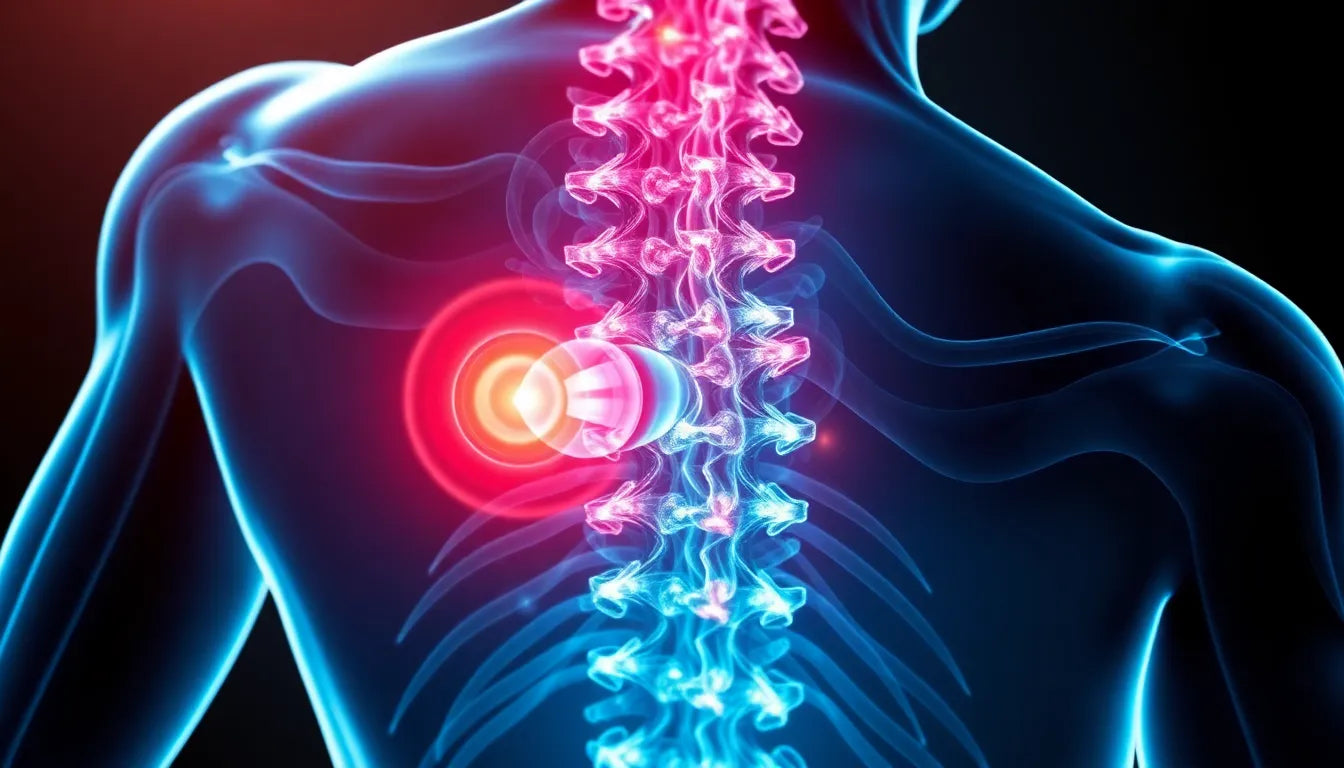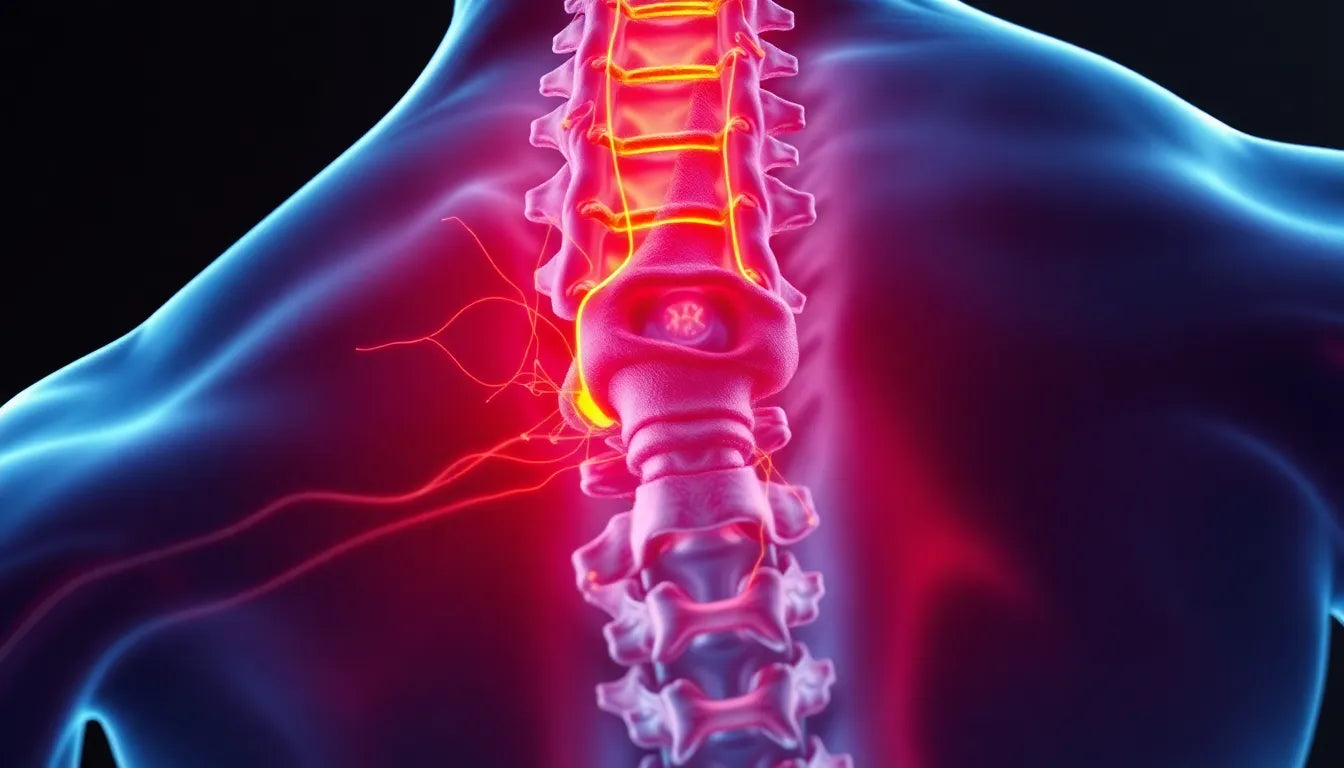Every year, countless individuals find themselves grappling with the discomfort and limitations caused by lumbar herniated discs. This condition affects a significant portion of the population, with estimates suggesting that up to 2% of people will experience a herniated disc in their lifetime. The lumbar spine, situated in the lower back, plays a crucial role in supporting the body's weight and enabling a wide range of movements. However, when things go awry, the consequences can be both painful and debilitating.
Understanding lumbar herniated discs
A lumbar herniated disc occurs when the soft inner material of an intervertebral disc pushes through a tear in the tougher exterior, often leading to nerve irritation and pain. Located in the lower back, these discs serve as cushions between the vertebrae, absorbing shocks and allowing for flexibility. When a disc herniates, it can impinge on nearby nerves, leading to symptoms that may include back pain, leg pain, and even numbness or weakness.
The anatomy of the lumbar spine is complex, with intervertebral discs playing a pivotal role in maintaining spinal health. These discs are composed of a gel-like center known as the nucleus pulposus, surrounded by a tougher outer layer called the annulus fibrosus. Together, they help in distributing loads and providing mobility. A herniated disc disrupts this balance, potentially affecting daily activities and overall quality of life.
The importance of understanding the condition
Recognizing and understanding the implications of a lumbar herniated disc is vital for several reasons. Firstly, the condition can significantly impact one's quality of life, affecting everything from mobility to the ability to perform everyday tasks. Secondly, early diagnosis and intervention are crucial in managing symptoms effectively and preventing further complications. By being informed about the condition, individuals can seek timely medical advice, explore appropriate treatment options, and make informed decisions about their health.
In the following sections, we will delve deeper into the medical and diagnostic aspects of lumbar herniated discs, explore the various treatment options available, and discuss the potential for natural recovery. Understanding these facets is essential for anyone affected by or at risk of this prevalent condition.
Medical and diagnostic overview of lumbar herniated discs
Understanding the severity and impact of a lumbar herniated disc is crucial for determining the appropriate treatment path. The condition can range from mild to severe, depending on how much of the disc material has protruded and the degree to which it compresses the spinal canal and nerves. This compression can lead to symptoms such as sciatica, where pain radiates along the sciatic nerve from the lower back down to the legs.
Diagnostic imaging, particularly Magnetic Resonance Imaging (MRI), plays a pivotal role in assessing lumbar herniated discs. MRI scans provide detailed images of the spine's soft tissues, allowing healthcare professionals to evaluate the extent of herniation and its impact on surrounding structures. According to insights from The Radiology Assistant, MRI is the gold standard for diagnosing this condition, offering a non-invasive method to visualize the spine and guide treatment decisions.
Treatment approaches for lumbar herniated discs
Non-surgical options
For many individuals, non-surgical treatments can effectively manage symptoms associated with lumbar herniated discs. Physical therapy is often the first line of defense, focusing on exercises that strengthen the back muscles, improve flexibility, and reduce pressure on the affected nerves. Acupuncture and cognitive behavioral therapy are also popular alternatives, offering pain relief and helping patients manage the psychological aspects of chronic pain.
Here is a comparison of some common non-surgical treatments:
| Treatment | Benefits | Potential Drawbacks |
|---|---|---|
| Physical Therapy | Improves strength and mobility | Requires consistent effort and time |
| Acupuncture | Can reduce pain and inflammation | Varied effectiveness among individuals |
| Cognitive Behavioral Therapy | Helps manage pain perception | Does not address physical symptoms directly |
Surgical options
When conservative treatments fail to provide relief, or if the condition severely impacts daily life, surgical interventions may be considered. Procedures such as microdiscectomy, spinal fusion, and artificial disc replacement are common surgical options. Microdiscectomy involves removing the portion of the disc that is pressing on the nerve, while spinal fusion stabilizes the spine by fusing two or more vertebrae. Artificial disc replacement is a newer technique that replaces the damaged disc with an artificial one, preserving motion at the affected segment.
Surgery is generally considered when symptoms persist despite several months of conservative treatment, or if there is significant nerve damage or loss of function. The decision to proceed with surgery should be made in consultation with a healthcare professional, taking into account the patient's overall health and specific circumstances.
Spontaneous regression of herniated discs
An intriguing aspect of lumbar herniated discs is the potential for spontaneous regression, where the herniated material reduces in size naturally over time. Studies published in the Nagoya Journal of Medical Science and the Pain Physician Journal highlight cases where patients experience significant improvement without surgical intervention. This natural recovery process can occur due to the body's immune response, which gradually absorbs the herniated material.
While spontaneous regression offers hope for avoiding surgery, it is not guaranteed for all patients. Factors such as the size of the herniation and individual health conditions can influence the likelihood of natural recovery. Nonetheless, for many, this phenomenon underscores the importance of patience and exploring all treatment options before opting for surgery.
In the next section, we'll explore more evidence-based insights and personalized treatment options, helping patients and healthcare providers make informed decisions about managing lumbar herniated discs.
Meta-analysis and evidence-based insights
The decision between conservative treatments and surgical interventions for lumbar herniated discs often depends on the severity of the condition and patient-specific factors. A systematic review by PMC highlights that while surgical options like lumbar discectomy can offer quicker relief for severe cases, conservative treatments remain effective for many individuals with milder symptoms. This data-driven approach underscores the importance of tailoring treatment plans to the individual's needs, balancing the benefits and risks of each option.
Evidence-based practice is crucial in managing lumbar herniated discs, as it ensures that patients receive the most effective care based on current research. By integrating findings from systematic reviews and clinical studies, healthcare providers can make informed decisions that enhance patient outcomes and satisfaction.
Localized and patient-focused insights
Developing personalized treatment plans is essential for managing lumbar herniated discs effectively. Factors such as age, activity level, and overall health can influence the choice of treatment, whether conservative or surgical. For instance, younger, more active patients may benefit from interventions that preserve mobility, such as artificial disc replacement, while older individuals may prioritize stability and pain relief.
Patient education plays a pivotal role in managing expectations and improving outcomes. By understanding their condition and the rationale behind different treatment options, patients are better equipped to engage in their care and make informed decisions. This collaborative approach fosters a sense of empowerment and can lead to more satisfactory results.
Frequently asked questions
What are the common symptoms of a lumbar herniated disc?
Common symptoms include back pain, leg pain, numbness, and weakness. These symptoms result from nerve irritation caused by the herniated disc material pressing on nearby nerves. Pain may radiate along the path of the affected nerve, often leading to discomfort in the legs or feet.
Can a lumbar herniated disc heal on its own?
Yes, in some cases, a lumbar herniated disc can heal through a process known as spontaneous regression. This natural recovery occurs when the body gradually absorbs the herniated material, reducing pressure on the nerves. Factors such as the size of the herniation and individual health can influence the likelihood of spontaneous healing.
When should I consider surgery for a herniated disc?
Surgery is typically considered when symptoms persist despite several months of conservative treatment or if there is significant nerve damage or loss of function. Indicators for surgical intervention include severe pain, weakness, or bowel and bladder dysfunction. Consulting with a healthcare professional is crucial to evaluating the risks and benefits of surgery.
How can lifestyle changes help manage a herniated disc?
Lifestyle changes such as regular exercise, maintaining good posture, and making ergonomic adjustments can significantly alleviate symptoms. Exercises that strengthen the core and improve flexibility can help support the spine and reduce pressure on the affected area. Additionally, being mindful of posture and using supportive furniture can prevent further strain on the back.
Are there any alternative therapies that can help?
Alternative therapies like chiropractic care and acupuncture can complement traditional treatments. Chiropractic adjustments may help realign the spine and relieve pressure on nerves, while acupuncture can reduce pain and inflammation. It is essential to discuss these options with a healthcare provider to ensure they align with the overall treatment plan.
Sources
- The Radiology Assistant. "Lumbar Disc Herniation."
- Spine-health. "Treatment for a Lumbar Herniated Disc."
- Nagoya Journal of Medical Science. "Spontaneous Regression of Lumbar Disc Herniation: A Case Report and Literature Review."
- Pain Physician Journal. "Spontaneous Regression of Lumbar Disc Herniation: An Overview."
- PMC – Systematic Review. "Conservative Treatments Versus Lumbar Discectomy: A Systematic Review."
- Cuéllar Spine. "Treatments for Herniated Disc."


















